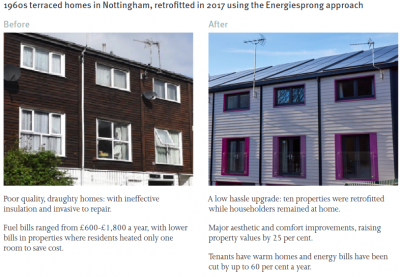Posted by: @jamespa@derek-m Thanks for the analogy but I'm not sure how it changes the fundamentals. If the HP is forced to cycle because it can't maintain a steady state output at the (low) level of the heat loss from the house, then during the on periods the flow temperature will need to be higher than would be the case if it were on continuously, for any given total energy delivered. Thus it will be operating at a lower COP than would be the case we're it to be operating continuously, because because cop reduces with increased flow temp.
The period of the on-off will depend on various system parameters most particularly volume, permitted hysyerisis of flow temp and the difference between the min hp output and the demand, but the mark-space (on-off) ratio will be the ratio of required output to minimum output, irrespective of system volume etc.
All of course 'to first order', ie based on the fundamentals only, and assuming that the target temperature is reached.
Are you arguing that this is not the case or am I missing some other point?
I'm not changing the fundamentals, there is a minimum thermal energy output that a given heat pump can produce when operating at its lowest possible operating parameters for continuous operation. If you try to operate the heat pump below these minimum settings, then it will cycle.
The LWT doesn't NEED to be higher, it is FORCED higher because the thermal energy is not being transferred at the required rate. If the LWT setting is set too high, then your statement could be somewhat correct, but that is not what I am saying. COP increases with inefficient operation.
If the heat energy demand is insufficient to absorb the thermal energy output from the heat pump, then the LWT will increase whatever the desired setting. The LWT increases until the compressor is stopped because the LWT is too high. As the thermal energy is absorbed and emitted by the heat emitters, the LWT falls to the point where the compressor is restarted.
I would suggest that you do not get too fixated on the COP, but rather on reducing energy consumption whilst avoiding short cycling.
Yes, but is also running for less time, and the two may cancel out, partly or wholly.
According to the basic physics, no they won't.
Obviously there might be 'engineering' effects, but the basic physics says that running continuously is more efficient than cycling for a given total energy delivered, because of the lower flow temp required in continuous mode.
The LWT doesn't NEED to be higher, it is FORCED higher because the thermal energy is not being transferred at the required rate
Sorry but it does NEED to be higher to deliver the same energy from the emitters to the house in the shorter period of time available (because it is only on part of the time). Remember the thing that is fixed is the amount of energy which must be delivered into the house to balance the energy lost.
For clarity I'm talking about periods where the objective is to maintain the house temperature not for it to fall, that's a whole different discussion)and more complex). I completely agree that it is possible that setback during periods when you don't need the house to be warm may well save energy.
4kW peak of solar PV since 2011; EV and a 1930s house which has been partially renovated to improve its efficiency. 7kW Vaillant heat pump.
Posted by: @jamespa
Posted by: @cathoderayYes, but is also running for less time, and the two may cancel out, partly or wholly.
According to the basic physics, no they won't.
Obviously there might be 'engineering' effects, but the basic physics says that running continuously is more efficient than cycling for a given total energy delivered, because of the lower flow temp required in continuous mode.
The LWT doesn't NEED to be higher, it is FORCED higher because the thermal energy is not being transferred at the required rate
Sorry but it does NEED to be higher to deliver the same energy from the emitters to the house in the shorter period of time available (because it is only on part of the time). Remember the thing that is fixed is the amount of energy which must be delivered into the house to balance the energy lost.
Now that statement I can agree with.
The problem is that in mild weather conditions it is not possible to run heat pumps continuously, whatever you try, so it is necessary to use the minimum amount of energy consumption whilst avoiding short cycling.
The COP value is not really important since in mild weather conditions the heat demand and energy consumption will be much lower than colder conditions.
Posted by: @jamespaObviously there might be 'engineering' effects, but the basic physics says that running continuously is more efficient than cycling for a given total energy delivered, because of the lower flow temp required in continuous mode.
Consider this situation, that just happens to happen in a period of remarkably stable weather conditions: one day, I run the heating all the time, LWT is relatively low, and my COP is 4; the next day (imagine no spill over effects, we are just comparing running states, and consider this possible), I only run the heat pump from 0800 to 2000 (50% of the time); the LWT is indeed higher, and the COP falls (to 3). Doesn't this mean that I use 25% (or is it 33%, my numeracy is hopeless on these things) more energy on the second day when the system is running, but as I am only running 50% of the time, overall, I use less energy eg (using easy round numbers):
day one total use: 1 kWh per hour x 24 hours = 24 kWh total over the 24 hour period
day two: 1.25 kWh per hour but only for 12 hours = 15 kWh total over the 24 hour period
Day one in effect was continuous running, day two in effect was cycling, albeit one big cycle. Mightn't the same basics maths apply to short cycling (more use when on, but on for less time)?
Midea 14kW (for now...) ASHP heating both building and DHW
Posted by: @cathoderayOlder housing stock needing properly designed retrofit solutions are very much part of the big picture;
There are some very effective and innovative success stories to tackle this problem.
A good example is the trial partnership between Devon County Council, EnergieSprong and Zebcat.
They clad existing terraced homes with a super-insulated jacket, which is craned into place over two days.
The same EnergieSprong solution has been used in Nottingham:
The design incorporates a rear porch housing the new heat-pump and other energy-related hardware.
However... the solution is expensive at £85-£100k per house.
It's just about cost effective for a Housing Association because they don't have to re-house tenants whilst the work is done.
Save energy... recycle electrons!
Posted by: @transparentHowever... the solution is expensive at £85-£100k per house.
Eeek! Also not quite the done thing to a listed building, but of course they are very much in the minority.
Midea 14kW (for now...) ASHP heating both building and DHW
Posted by: @derek-mThe problem is that in mild weather conditions it is not possible to run heat pumps continuously, whatever you try, so it is necessary to use the minimum amount of energy consumption
True
Posted by: @derek-mwhilst avoiding short cycling
Thermodynamically maybe not true.
Short cycling will result in a reduced requirement for higher flow temp than long cycling so thermodynamically it's more efficient so far as I can see. Of course this is at the expense of greater wear and tear on the compressor and more start up transients, so there will, I think, be an engineering trade off, moving quite possibly in the direction of favouring short cycling as compressors get better at soft start
4kW peak of solar PV since 2011; EV and a 1930s house which has been partially renovated to improve its efficiency. 7kW Vaillant heat pump.
Let's see if we can agree upon some things.
Say that at minimum operating parameters a heat pump is producing 2.5kW of heat energy, but the heat loss of the home is only 2kW. The heat pump sends out 2.5kW of heat energy, the heat emitters absorb 2kW of heat energy, and 0.5kW of heat energy is returned to the heat pump in the form of warmer RWT. Because the RWT is higher and 2.5kW of heat energy is still being supplied to the water, the LWT will increase. The higher LWT will increase the temperature of the heat emitters, who will now emit slightly more heat energy, but not 2.5kW worth.
If this situation were to continue the LWT would eventual increase to the point where the heat emitters would be emitting 2.5kW of heat energy, but the indoor temperature would also need to increase until the heat loss was 2.5kW. The system would then be in balance.
The heat pump controls do not allow the LWT to keep increasing, but stop the compressor if it gets too high. By this time the LWT is higher than it would need to be, not because it wanted to increase, but because it was forced to increase. The additional energy stored within the water and the heat emitters supplies the heat demand until the LWT falls to the point where the compressor is restarted.
The higher LWT is a consequence of the low heat demand and compressor cycling, not causing the cycling.
Posted by: @jamespaPosted by: @derek-mThe problem is that in mild weather conditions it is not possible to run heat pumps continuously, whatever you try, so it is necessary to use the minimum amount of energy consumption
True
Posted by: @derek-mwhilst avoiding short cycling
Thermodynamically maybe not true.
Short cycling will result in a reduced requirement for higher flow temp than long cycling so thermodynamically it's more efficient so far as I can see. Of course this is at the expense of greater wear and tear on the compressor and more start up transients, so there will, I think, be an engineering trade off, moving quite possibly in the direction of favouring short cycling as compressors get better at soft start
I wouldn't recommend stating that if your compressor breaks and you wish to claim a replacement under warranty. 🙄
Posted by: @fazel@jamespa @derek-m I see no one mentioned this before, by leaving a window open you can increase the heat loss to eventually achieve equilibrium, thus the HP can run continuously
That's a brilliant idea, why didn't I think of that. 🙄
Or you could just switch off the heat pump for a couple of hours and then switch it back on. 😎
Posted by: @derek-mOr you could just switch off the heat pump for a couple of hours and then switch it back on. 😎
More efficient still, don't switch it back on and put on a jumper.
4kW peak of solar PV since 2011; EV and a 1930s house which has been partially renovated to improve its efficiency. 7kW Vaillant heat pump.
- 26 Forums
- 2,356 Topics
- 53.4 K Posts
- 268 Online
- 6,017 Members
Join Us!
Worth Watching
Latest Posts
-
RE: Octopus Cosy Heat Pump Owners & Discussion Thread
@kevh with the Cosy 6 I know it definitely goes to arou...
By HarrisonC , 2 hours ago
-
RE: Setback savings - fact or fiction?
@cathoderay yes I am familiar with SQL. Interesting num...
By RobS , 3 hours ago
-

Parsnip, Bacon & Coconut Milk Soup
First let me say, I am only a cook because I am human a...
By Toodles , 3 hours ago
-

RE: Controlling Daikin Altherma via P1P2 and Home Assistant
@weoleyric Oh Dear, I don’t think I am going to be of m...
By Toodles , 4 hours ago
-
RE: Electricity price predictions
Ben Watts posted on LinkedIn that he had updated this w...
By Judith , 9 hours ago
-

RE: The good, the bad and the not that great – my heat pump installation
Small update, Emailed and Spoke to Midea UK and they ...
By Burtis , 9 hours ago
-
RE: Solis S6-EH1P8K-L-PLUS – Why I Chose It and What I’ve Learned So Far
@bash Octopus does charge for the admin. The process al...
By Batpred , 10 hours ago
-
RE: External pipework insulation
@transparent HI all The products you mention are ver...
By David Smith , 10 hours ago
-
RE: New Fogstar 15.5kWh upright solution
Issues still under investigation by Solis... Fogstar ...
By Batpred , 10 hours ago
-
RE: Who's your electricity provider and what's your tariff?
I agree, the consumer is not being properly represented...
By Batpred , 10 hours ago
-
RE: Advice on internal circulation pump noise
Thanks @mikefl - I'll maybe have a look at the lock-shi...
By jtg , 1 day ago
-

RE: Heat Pump Heats the House… But It’s Not Cosy. Emitter Changes or System Tweak?
@toodles interesting suggestion, thanks. I will try to...
By GrahamF , 1 day ago
-
RE: Mitsubishi Ecodan Auto Adaption trial to stop cycling.
The interval you talk of, i think, will be 60min for an...
By F1p , 1 day ago
-
Agree with @majordennisbloodnok on the setbacks. We hav...
By ChandyKris , 2 days ago
-

RE: Speedcomfort radiator fans
@deltona the way the links were added broke the page. A...
By Mars , 2 days ago
-

RE: Refrigerant R32, is it now banned in the EU from 1st Jan 2027 for monobloc ASHPs?
This has been delayed from what I believe to be this ye...
By dgclimatecontrol , 2 days ago
-
RE: Are We Sleepwalking Into Another Race to the Bottom?
this is why I provided current flow temperatures in the...
By ksim , 2 days ago
-

RE: Why Millions of UK Homes Struggle With Heat Pumps
There's many homes that would be quite a disruption for...
By dgclimatecontrol , 2 days ago
-
RE: Ecodan unable to hit legionella target temp - what's the consensus?
@rhh2348 ...maybe this option is what you want? Alter...
By benson , 2 days ago






